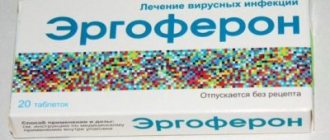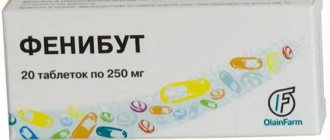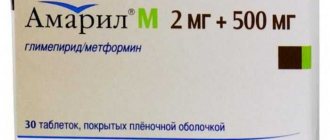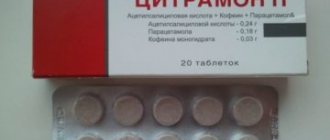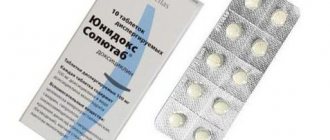When skeletal muscles and the spinal cord are damaged, clonic convulsions often occur, and pain occurs due to spasms and tension of elastic tissues. For multiple sclerosis, back injuries, compression of sensitive structures of the spine, the drug Tizanidine is prescribed to reduce pain and discomfort.
The muscle relaxant acts quickly, has a positive effect on the condition of muscle tissue, and relieves the patient of painful spasms. This potent drug can be taken strictly as directed by a vertebrologist or neurologist: there have been cases of pronounced side effects during therapy. The instructions indicate the rules for using a powerful muscle relaxant that the patient must know and follow.
Action of a muscle relaxant
Tizanidine hydrochloride suppresses the sensitivity of alpha2-adrenergic receptors of the central nervous system located at the spinal and superspinal levels. The active component suppresses the synthesis of amino acids that stimulate NMDA receptors. The consequence is a reduced risk of developing clonic convulsions and painful spasms, which reduces the resistance force of muscle tissue and increases the range of active movements in the joints. There is no direct effect of the drug on monosynaptic reflexes and skeletal muscles.
The active substance is rapidly absorbed; blood plasma tests show the maximum concentration of tizanidine hydrochloride after 1–2 hours. Bioavailability – 30% or more. Inactive metabolites are formed by the liver, the main part of the compounds is excreted unchanged through natural filters (up to 70%) and with feces (up to 20%).
Before starting treatment, it is important to clarify the indications for creatinine clearance in patients with renal failure: in the blood plasma, the concentration of tizanidine with CC below 25 ml per minute increases by 2 times.
Find out about the benefits of an orthopedic chair cushion, as well as how to choose the right product.
Read about what a Schmorl defect of the spine is and what methods can be used to get rid of the formation at this address.
Nuances of use for special categories of patients
This drug is not used in childhood, since there is no reliable data on the ability to influence the formation of a growing organism.
Article on the topic: Review of pain-relieving injections for joint pain
Since Tizanidine is almost completely absorbed into the blood , it is not used during pregnancy and lactation, since there is a high probability of developing pathologies in the child.
In old age, the drug is taken under the supervision of specialists, since there is a risk of developing renal and liver failure. Health status is monitored daily.
If necessary, the dose and frequency of doses are adjusted by the attending physician.
Indications for use
The drug is prescribed to patients with convulsive syndrome, pronounced muscle spasm against the background of pathologies:
- spinal cord damage;
- multiple sclerosis;
- painful muscle spasms due to functional damage to the supporting column;
- in the postoperative period after treatment of disc herniation and osteoarthritis;
- degenerative lesions of the spinal cord;
- chronic myelopathy;
- back and spine injuries;
- as part of complex therapy after a stroke.
Analogs
“Sirdalud”
Novartis Pharma, Switzerland Price from 350 to 400 rubles.
“Sirdalud” is considered a relaxant that affects skeletal muscles. The main site of action of the drug is the spinal cord. The product relieves painful muscle spasms and improves their contraction. Available in the form of white tablets, the main active ingredient is tizanidine hydrochloride.
pros
- Effectively relieves pain and spasms
- Well absorbed by the gastrointestinal tract
Minuses
- Incompatible with many medications
- There are a considerable number of contraindications.
“Mydocalm”
Gedeon Richter OJSC, Hungary Price from 370 to 450 rubles.
“Mydocalm” is a centrally acting muscle relaxant that blocks muscle spasms and has an analgesic effect. The active ingredient is tolperisone. Recommended for patients with muscle spasms, in the treatment of musculoskeletal disorders, orthopedic injuries, and certain ailments of the nervous system.
pros
- Eliminates muscle spasm in a short time.
- Effective for diseases of the spine
Minuses
- Not suitable for children
- Lots of side effects.
“Tizalud”
Veropharm OJSC, Russia Price from 150 to 250 rub.
“Tizalud” affects hypertonicity and muscle spasms that arise as a result of diseases of the nervous system and musculoskeletal system. Available in the form of tablets and solution for injection.
pros
- Has a high therapeutic effect.
- Well tolerated by patients
Minuses
- Do not take during pregnancy or breastfeeding.
- When taking the drug, a sedative effect may develop.
Contraindications
The muscle relaxant Tizanidine is not suitable for patients in the following cases:
- severe liver damage;
- allergic reactions to the active component of the antispastic agent or excipients;
- breastfeeding and pregnancy;
- the patient is under 18 years of age;
- lactase enzyme deficiency;
- galactose-glucose malabsorption;
- the patient receives Ciprofloxacin or Fluvoxamine or alpha2-adrenergic agonists;
- Milk sugar intolerance has been identified.
Contraindications and precautions
“Tizanidine”, as well as “Tizanidin-Teva”, are prohibited from taking in the following cases:
- Increased sensitivity to components
- Pregnancy and breastfeeding
- Children under 15 years old.
In case of renal failure and serious liver diseases, the medicine should be taken with extreme caution, with mandatory supervision by a specialist. People over 65 years of age should also take the medicine with caution. Concomitant use with alcohol is not recommended, since alcoholic beverages enhance the sedative effect of the medication. “Tizanidine” and “Tizanidin-Teva” should not be taken while driving.
Instructions for use
Important points:
- The initial dosage is 2 mg tizanidine hydrochloride. The patient takes the pills for three to four days and monitors the condition of the body. If the result is positive and there are no severe adverse reactions, the daily dose is increased by 2 mg no more often than every 3–4 days;
- The maximum dosage for 24 hours is 36 mg. Most often, the patient receives no more than 24 mg of the active ingredient per day, the norm should be divided into three or four doses;
- consumption of drinks and food does not affect the bioavailability of the active substance. There is no need to chew the medicine during administration. Be sure to take the muscle relaxant tablet with lukewarm water - up to 150 ml;
- After 65 years, the drug is allowed to be used, but with caution. It is important to periodically take a urine test to monitor glomerular filtration rate, which is often reduced in elderly patients;
- in case of renal failure, the patient receives 2 mg of the antispastic component once a day during the first days. If the medication is well tolerated, the dosage is first increased, and later the frequency of use;
- patients with heart disease need to periodically visit a cardiologist, do an ECG, monitor the functions of the heart muscle, blood pressure readings;
- if fatigue, nausea without eating, anorexia, increased clinical symptoms, or increased enzyme activity occur, the patient should take a blood test for the liver complex. If the level of ALT, GGT, AST is 3 or more times higher than the standard values, then you need to find a replacement antispastic agent based on tizanidine hydrochloride.
Important! It is forbidden to abruptly stop taking tablets with an antispastic effect: “withdrawal syndrome” often occurs. Patients complain of tachycardia, sudden jumps in blood pressure, and possible problems with cerebral circulation. The doctor will indicate how to properly reduce the dosage for a particular patient before replacing Tizanidine with another formulation or stopping the course of treatment during recovery.
Overdose and adverse reactions
If the dosage of this drug is accidentally or intentionally increased, overdose symptoms may develop, which are manifested by clinical signs such as:
- dizziness;
- nausea;
- noise in ears;
- fainting;
- pain in the epigastric abdomen;
- bradycardia;
- hypotension.
In especially severe cases coma may develop , which can lead to death without timely medical care.
If an overdose is detected, symptomatic treatment is performed aimed at restoring the vital functions of the body. The action plan includes a number of actions such as:
- reduce the concentration of toxins in the body by washing the stomach and intestines, as well as introducing a sorbent;
- normalize blood pressure and heart rate;
- introduce saline solutions that are necessary to maintain the body.
If there is hypersensitivity to the components of the drug, as well as non-compliance with recommendations regarding taking tablets, adverse reactions may develop. The most common of them are:
- dry mouth;
- decreased quality of vision;
- drowsiness;
- decreased concentration;
- chronic fatigue syndrome;
- muscle spasms;
- hallucinations;
- a sharp decrease in heart rate and blood pressure to critical levels.
Somewhat less common are clinical manifestations caused by individual intolerance to the drug, such as:
- ventricular tachycardia;
- state of deep depression;
- psycho-emotional disorder;
- aching joints;
- headache;
- lack of appetite;
- tremor;
- decreased body temperature, chills;
- limb spasms;
- facial nerve paresis.
If adverse reactions are detected, it is necessary to stop the course of treatment, as well as carry out symptomatic treatment.
In most situations, the drug is replaced with a drug that is similar in effect, but different in composition and method of action.
When the drug is discontinued abruptly, the risks of developing arrhythmia, tachycardia and hypertension increase. In some cases, cerebrovascular accident may develop.
Side effects
A powerful muscle relaxant is used under the supervision of a physician: the active substance quickly eliminates muscle spasms, but often has a negative effect on the central nervous system, digestive tract, and heart. Depending on individual sensitivity, the occurrence of adverse reactions ranges from the “very rare” to “common” category.
Many patients complain of negative symptoms:
- drowsiness;
- high fatigue;
- withdrawal syndrome;
- bradycardia;
- low pressure;
- dizziness;
- The mucous membranes in the mouth dry out.
Other rare reactions to an antispastic agent include:
- muscle weakness;
- sleep disorder;
- nausea;
- urge to vomit;
- temporary increase in the levels of AST, GGT and ALT;
- dysfunction of the digestive tract.
Instructions for Tizanidine (tablets)
- home
- Instructions for Tizanidine (tablets)
< Return to previous page
Name: Tizanidine Release form: tablets Dosage: 2 mg; INN: Tizanidine ATC code: M03BX02 Group: Drugs for the treatment of diseases of the musculoskeletal system Subgroup: Muscle relaxants Pharmaceutical group: Centrally acting muscle relaxants Pharmaceutical subgroup: Other centrally acting muscle relaxants
Characteristics: White or slightly yellowish crystalline powder. Pharmaceutical group: centrally acting muscle relaxant. Pharmaceutical action: Centrally acting muscle relaxant. Stimulates presynaptic alpha2-adrenergic receptors, which leads to inhibition of polysynaptic transmission of excitation in the spinal cord, which regulates the tone of skeletal muscles. Effective for acute painful muscle spasms and chronic spasms of spinal and cerebral origin. Reduces muscle stiffness during passive movements. Pharmacokinetics: Absorption - high; TCmax - 1-2 hours. Bioavailability - 34%. Food intake does not affect pharmacokinetics. Volume of distribution - 2.6 l/kg. Communication with plasma proteins - 30%. In the dose range from 4 to 20 mg, pharmacokinetics are linear. Metabolized quickly and largely in the liver (95%) with the formation of inactive metabolites. T1/2 - 3-5 hours. Excreted mainly by the kidneys (70% unchanged, 2.7% in the form of metabolites) and with feces (20%). In patients with renal failure (creatinine clearance less than 25 ml/min), Cmax increases by 2 times, T1/2 - 14 hours, AUC increases by 6 times. Indications: Painful muscle spasms caused by organic and functional disorders of the spine (cervical and lumbar syndromes, osteochondrosis, spondylosis, syringomyelia, hemiplegia) occurring after surgical operations (including for a herniated disc or osteoarthritis of the hip joint), skeletal spasticity muscles in various neurological diseases (including multiple sclerosis, chronic myelopathy, degenerative diseases of the spinal cord, residual effects of a stroke, head injury, cerebral palsy). Category of action on the fetus: CATEGORY OF EFFECT ON THE FETUS. C (Animal reproduction studies have revealed adverse effects on the fetus, and adequate and strictly controlled studies in pregnant women have not been conducted, but the potential benefits associated with the use of the drug in pregnant women may justify its use, despite the possible risk.) Contraindications: Hypersensitivity, severe liver failure, simultaneous use with powerful inhibitors of the CYP1A2 isoenzyme (fluvoxamine, ciprofloxacin), pregnancy, lactation, childhood. Carefully. Hepatic and/or renal failure, arterial hypotension, bradycardia, congenital long QT syndrome, concomitant use of oral contraceptives, age over 65 years. Dosage: Relief of painful muscle spasms: orally, in the form of tablets 2-4 mg 3 times a day, in severe cases - an additional 2-4 mg at night. Treatment of spasticity caused by neurological diseases: initial dose - 2 mg 3 times a day, then the dose is gradually increased by 2-4 mg at intervals of 3-7 days. The optimal daily dose is 12-24 mg in 3-4 doses; the maximum daily dose is 36 mg. Capsules: initial dose - 6 mg, after 3-7 days the dose can be increased to 12 mg, maximum daily dose - 24 mg. For patients with renal failure (with CC less than 25 ml/min), the recommended initial dose is 2 mg 1 time per day. The dose is increased gradually, slowly, taking into account tolerability and effectiveness. If it is necessary to obtain a more pronounced effect, it is recommended to first increase the dose prescribed once a day, then increase the frequency of administration. Side effects: Frequency: very often (more than 1/10); often (more than 1/100 and less than 1/10); uncommon (more than 1/1000 and less than 1/100); rare (more than 1/10000 and less than 1/1000); very rare (less than 1/10000), including isolated reports. From the nervous system: often - drowsiness, dizziness; rarely - hallucinations, insomnia, sleep disturbances. From the cardiovascular system: often - bradycardia, decrease in blood pressure (in some cases pronounced, up to collapse and loss of consciousness). From the digestive system: often - dryness of the oral mucosa; rarely - nausea, dyspepsia, increased activity of liver transaminases; very rarely - hepatitis, liver failure. From the musculoskeletal system: rarely - muscle weakness. Other: often - fatigue; hypercreatininemia. In case of abrupt withdrawal after prolonged treatment and/or taking high doses of the drug (as well as after simultaneous use with antihypertensive drugs): tachycardia, increased blood pressure, in some cases - acute cerebrovascular accident. Overdose: Symptoms: nausea, vomiting, marked decrease in blood pressure, dizziness, drowsiness, miosis, anxiety, respiratory failure, coma. Treatment: gastric lavage, repeated administration of activated carbon, forced diuresis, symptomatic therapy. Interaction: Antihypertensive drugs increase the risk of a pronounced decrease in blood pressure and bradycardia. Combination with other alpha2-adrenergic agonists is not recommended. Sedative drugs and ethanol increase CNS depression. Paracetamol increases TCmax by 16 minutes (no clinical significance). Oral contraceptive drugs reduce the clearance of tizanidine by 50%. Special instructions: When prescribed at a dose of 12 mg or higher, liver function assessment is necessary once a month for the first 4 months of treatment. If the activity of AST and ALT persistently exceeds the upper limit of normal by 3 times or more, stop taking the drug. During treatment, you should refrain from drinking ethanol and be careful when driving vehicles and engaging in other potentially hazardous activities that require increased concentration and speed of psychomotor reactions. Due to the threat of withdrawal syndrome, the dose of the drug is reduced gradually.
< Return to previous page
Overdose
An increased concentration of tizanidine hydrochloride provokes the development of negative reactions, including severe side effects:
- nausea;
- a sharp drop in pressure;
- drowsiness;
- gagging;
- miosis;
- dizziness;
- anxiety;
- respiratory dysfunction;
- coma.
View a selection of effective treatments for scoliosis in adolescents, and learn how to prevent further spinal deformity.
The characteristic symptoms and treatment of osteochondrosis of the cervical spine of the second degree are written on this page.
Follow the link and read about the features of treating a hernia of the lumbosacral spine using injection drugs.
Release form and composition
Tizanidine is available in the form of tablets in dosages of 2 mg and 4 mg.
The tablets from the Berezovsky Pharmaceutical Plant are biconvex, round, white or almost white, sometimes with a yellowish tint. They are packed in blisters of 10 pcs., in a cardboard pack of 3 blisters or in polymer jars of 30 pcs. or 100 pcs., in a cardboard pack 1 jar and instructions for use of Tizanidine.
Tablets produced by JSC Vertex are flat-cylindrical, round, white or white with a yellowish tint, with a chamfer. The drug with a dosage of 4 mg has a cross-shaped mark. Tablets are packaged in blisters of 10, 15, 20 or 30 pcs., in a cardboard box 3 or 6 blisters of 10 tablets, 2 or 4 blisters of 15 tablets, 3 blisters of 20 tablets, 1 or 2 blisters of 30 tablets; in polymer jars of 30 pcs. or 60 pcs., 1 can in a cardboard pack.
Composition per 1 tablet:
- active ingredient: tizanidine (in the form of tizanidine hydrochloride) – 2 mg or 4 mg;
- auxiliary components: anhydrous lactose, microcrystalline cellulose, magnesium stearate, colloidal silicon dioxide.
Drug interactions
The instructions for the drug Tizanidine indicate the need to clarify the moments of simultaneous use of the antispastic agent with other drugs. Some formulations, when combined with tizanidine hydrochloride, increase the likelihood of side effects.
It is important to stop taking Tizanidine tablets or use caution when taking a muscle relaxant and the following drugs at the same time:
- Digoxin.
- Cimetidine.
- Hormonal compounds.
- Rofecoxib.
- Norfloxacin.
- Beta blockers.
- Medicines for arrhythmia.
Important points:
- an antispastic agent in combination with diuretics and drugs to lower blood pressure enhances the hypotensive effect, blood pressure levels can sharply decrease. It is possible to reduce the frequency of contractions of the heart muscle;
- when combined with ethanol and sedative compounds, Tizanidine has a negative effect on the central nervous system.
Tizanidine: side effects
When taking Tizanidine in the prescribed dosages, side effects almost never occurred. That is why the drug Tizanidine evokes only positive reviews from both doctors and patients. But in rare cases, digestive disorders, drowsiness, dizziness, nausea, weakness, dry mouth and hypotension (low blood pressure) are still possible.
At higher dosages, side effects such as hypotension, bradycardia (decreased heart rate), insomnia, weakness and acute hepatitis (extremely rare!) are possible.
Taking Tizanidine during pregnancy is not recommended! And although studies of the drug on animals did not reveal any negative aspects, it is not worth the risk! No studies have been conducted on pregnant women, reactions are unknown! In addition, it is also not recommended to take the drug during lactation (breastfeeding) - the medicine passes into mother's milk!
Tizanidine: analogues
For back muscle spasms, multiple sclerosis, clonic convulsions due to neurological and orthopedic pathologies, or damage to the spinal cord, you can replace Tizanidine with another muscle relaxant with a similar effect. Only a neurologist or vertebrologist prescribes the optimal type of medication: uncontrolled use of antispastic compounds is fraught with serious complications.
Effective analogues:
- Tizanil - Teva.
- Sirdalud.
- Tizalud.
If you are intolerant to tizanidine hydrochloride, your doctor will select a central muscle relaxant to combat painful spasms based on another active component. Antispastic tablets with a “softer” effect on the body give a good effect. Effective names: Mydocalm based on tolperisone (the drug is approved even at an early age, minimal risk of negative reactions), Baclofen with the active ingredient of the same name (used from 12 years of age, the drug is well tolerated).
pharmachologic effect
Centrally acting muscle relaxant. Reduces increased tone of skeletal muscles, relieves their spasm; reduces muscle resistance during passive movements, increases the strength of voluntary contractions. The muscle-relaxing effect of tizanidine is probably due to inhibition of spinal polysynaptic reflexes, which is associated with a decrease in the release of excitatory amino acids from the presynaptic terminals of spinal interneurons, as well as stimulation of α2-adrenergic receptors. Tizanidine does not affect the transmission of excitation at neuromuscular synapses.
Reviews
All opinions about Tizanidine can be divided into two categories:
- patients of the first group note the high effectiveness of the tablets as a means of combating painful spasms and pain, unwanted reactions are minimal or absent;
- the second category also positively evaluates the therapeutic effect, indicates relaxation of the back muscles, elimination of pain, but at the same time notes a high frequency of side effects. Complaints of weakness and pronounced drowsiness are common, which interferes with driving a car and performing complex types of work that require precision and maximum concentration.
It is no coincidence that the instructions contain a clause about gradually increasing the daily norm and monitoring the body’s reactions. In some patients, negative manifestations are pronounced, despite the rapid elimination of muscle spasms and pain, the selection of a safer muscle relaxant is required.
Tizanidine tablets act quickly, help relieve pain, and relax spasmodic muscles in diseases of the back and spine. The drug often causes side effects, which requires a reduction in the daily dose or discontinuation of the drug. If you complain of severe drowsiness, nausea, or dizziness, the doctor selects a muscle relaxant based on another active component in order to eliminate muscle spasms without developing negative symptoms.
Treating osteochondrosis with Sirdalud: indications and instructions for use
Sirdalud is considered one of the most popular and effective muscle relaxant drugs for the treatment of osteochondrosis. The drug relaxes spasmed muscles , relieves pain, and restores blood circulation in soft tissues.
Pharmacological action of the drug
Foreign analogues of the muscle relaxant drug have the following commercial names: Zanaflex, Softidin, Sirvasc
Sirdalud belongs to the muscle relaxants of the central mechanism of action, with the main active ingredient tizanidine.
Its effect reduces the transmission of excitation between intermediate spinal neurons - the cause of muscle hypertonicity.
The muscle relaxant Sirdalud relaxes the striated muscles in the human musculoskeletal system.
The main active ingredient Sirdalud has one more effect: the drug gives a moderate analgesic effect .
Sirdalud reduces the frequency of chronic seizures and relieves spasms. The muscle relaxant is actively used in the treatment of neurological pathologies of a spastic nature, suitable for acute and chronic periods of diseases.
One capsule of Sirdalud contains 6.8 mg of the active compound tizanidine hydrochloride, with additional components represented by sucrose, gelatin, starch, talc, ethylcellulose, titanium dioxide.
Sirdalud is produced in Germany and India under license from the Swiss pharmaceutical concern Novartis Pharma, Ag.
Contraindications to the drug
For special indications, the drug Sirdalud is prescribed to children under 17 years of age.
The muscle relaxant is used with caution in the treatment of patients after 70 years of age, in people with chronic liver and kidney diseases.
Sirdalud is contraindicated for the treatment of people with hypersensitivity to tizanidine.
Side effects
Very rarely there may be side effects from taking the drug. They are expressed by sleep disorders, muscle weakness, insomnia, hallucinations
When treated with Sirdalud in therapeutic, prescribed dosages, side effects are rare.
They are expressed extremely moderately and are considered quickly passing .
In very rare cases, patients may complain of dyspeptic disorders, general weakness, short-term hypotension, and dizziness.
is used with caution with antihypertensive and diuretic drugs.
The combination of drugs can provoke bradycardia with arterial hypertension.
Substances that potentiate Sirdalud include sirto-containing, sedative, hypnotic and antihistamine drugs.
In smokers, the systemic bioavailability of Sirdalud is reduced by almost three times. Therefore, in this case, a higher dosage of the drug is required than the average therapeutic one.
Overdose , which can occur after taking more than 400 mg of a muscle relaxant drug, is expressed by nausea, arterial hypertension, vomiting, dizziness, impaired respiratory function, and drowsiness.
Treatment of overdose is taking enterosorbents with forced diuresis.
Sirdalud for osteochondrosis
As a rule, sirdalud is used for acute osteochondrosis
Muscle relaxant drugs in complex treatment are a prerequisite for acute osteochondrosis.
In case of reflex overstrain of muscle tissue, muscle relaxants are needed in combination with painkillers, antispasmodics, anti-inflammatory drugs and chondroprotectors.
myotropic drugs Mydocalm, Baclofen, Tizanidine to treat osteochondrosis
Muscle relaxants, acting on the central nervous system, relax the transverse skeletal muscles, relieve pain, and make it possible to remove lactic acid and other breakdown products that arise from insufficient metabolism.
Sirdalud is prescribed with an adequate dosage, according to a clear scheme, with the development of persistent pain syndrome. Treatment with Sirdalud usually lasts up to a week.
Taking muscle relaxant drugs orally for osteochondrosis should be combined with external irritating ointments and local patches.
The use of muscle relaxants, including Sirdalud, is considered clinically unjustified if the pain syndrome in the patient is mild.
Analogues substitutes
On the pharmaceutical market, muscle relaxant drugs with the active ingredient tizanidine hydrochloride, in addition to Sirdalud, are presented:
Tizalud. Manufacturer: JSC Veropharm, Russia.
A muscle relaxant drug based on tizanidine hydrochloride in 2 mg tablets.
Tizalud is a centrally acting muscle relaxant, clinically and therapeutically effective, well tolerated by patients .
Its use is indicated for spastic conditions in skeletal muscles with pronounced pain syndrome in neurological diseases: degenerative changes, cerebrovascular accidents, multiple sclerosis, chronic myelopathies.
Tizalud is indicated for the treatment of pathologies of the spine and joints in the postoperative period (hernias, osteoarthritis).
Tizanidine
Tablets of 2 mg with the main active ingredient tizanidine hydrochloride.
Manufacturers: Berezovsky Pharmaceutical Enterprise (Russia), Teva Pharmaceutical Works Private Co (Hungary).
Instructions for use, indications and contraindications for the drug are the same as for Tizalud and Sirdalud.
The recommended initial dose of the drug is 2 mg.
Tizanil
Tablets 2,4,6 mg. Manufacturer Simpex Pharma Pvt. Ltd. (India).
Refers to central muscle relaxants, derivatives of tizanidine hydrochloride, an analogue of Sirdalud.
Relaxes the muscular system, indicated for chronic myelopathies, sclerotic changes, degenerative conditions of the spinal cord, strokes.
The muscle relaxant Tizanil is included in the complex therapy of osteochondrosis, intervertebral hernias, and post-traumatic cranial spasms.
Which muscle relaxant to use in the treatment of osteochondrosis is decided solely by a specialist .
Self-medication with muscle relaxants is strictly contraindicated and can cause irreparable harm to health!


